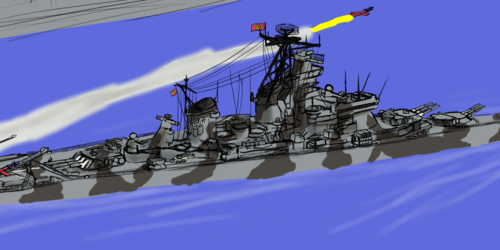Sign In
CloseAlmost totally finished with the linework now, just needs for more detail on the sides of the superstructure and a quick check when I'm not half asleep. Incidentally this is all placeholder colouring, hence ignoring the rather duff waterline and only correcting the camo where it's actively messing up the hull contours. I'm going to do the actual colouring in Clip Studio Paint but Sketchbook Pro is much better for sketchery. Have a vastly embiggened description!
For those wondering just how the Aludrans could be defeated so badly at Laurent Abyss, for comparison to the Lady Irene this is the Chiran flagship at the time, CDS Lady Katarina, launching a Strakken-M hybrid cruise missile.
Per tradition for the flagship of a major fleet, Lady Katarina's battle standard is actually riveted to her masthead. In the Chiran mind, a fleet's flagship is a representation of the hopes and dreams of an entire country, effectively becoming that country as long as her standard is raised; a flagship striking her colours would be unthinkable. It is thought this comes from the western province's tendency to have the West Temple bless their naval ensigns, especially those used by important ships, during the age of sail; the flag represented the blessing of one's ancestors, and running it down in battle was a grevious insult to them.
Useless fact: an image of Lady Katarina firing a broadside is the illustration for the Nine of Swords in the Aludran historic tarot deck.
Chiran Dominion Ship* Lady Katarina (Kasharina Suren)
CDS Lady Katarina, named after the Chiran empress' favourite mistress, a jackal from far to the east bought to her as a gift by a foreign merchant, was the lead ship of her class and the flagship of the Chiran Dominion fleet during the Battle of Laurent Abyss.
The Type 57 battleships, of which Lady Katarina was the first, were the first battleships to switch from cemented steel armour to layered composite, and featured a series of innovations in integrated fire control including allowing the central fire control system to remotely operate fuze setting equipment in the primary and secondary guns. Four mechanical central gun control computers controlled the ship's armament, with motors automatically setting certain variables using data transmitted directly from the ship's helm controls and detection equipment. During the Etrusean attack on the super-carrier Alana this system proved so accurate that at least one of the attacking Dragon bombers was destroyed by a direct hit from the Lady Katarina's main guns.
Lady Katarina was briefly laid up before the Battle of Laurent Abyss for minor repairs, and at the same time was fitted with new surface search and fire control radars and a vertically-mounted helium-neon laser that ran up the back of her main bridge superstructure to an emitter in the primary rangefinder for the forward turrets. This system was the first practical laser in the world, and gave the flagship unmatched accuracy at visual range.
The most destructive weapon deployed at Laurent Abyss is usually known by its Aludran title, Strakken-M (roughly "devastator-M"), while the Chiran name translates as "Spotted Swamp Moth." This hybrid cruise missile was a stopgap measure developed during the Chiran Unification War due to delays in development of a practical long-range remote-control system for missiles that could not easily be jammed using existing technology. Instead, Strakken used an existing unguided ethanol / peroxide / liquid oxygen rocket-glider designed for attacking fixed targets as a carrier for a 3,500lb glide bomb developed for use by aircraft. The primary modification to the carrier rocket was folding wings that automatically deployed when the launch rail was raised up to the deck, allowing eight complete rockets to be stowed on one battleship; in fleet engagements, some dispensed with their spotting planes to carry four more in the rear hangar.
Strakken required a large launching rail; Type 57 battleships had two such rails, which could retract behind doors in their stern. The lifting rams could pivot slightly outwards to angle the launch rail away from the ship, primarily to deal with crosswind launches that might otherwise impact the superstructure. Since Strakken's carrier stage was unguided, the weapon could only be aimed by pointing the entire ship at the target.
Just before launching, the crew would set a timer in the glide bomb for separation from the carrier, using data from a spotting aircraft to approximate the distance; effective range was up to one hundred miles. At the point of separation, explosive bolts were detonated, the signal receivers set to listen, and the warhead armed. The Strakken glide bomb was usually guided using IR on a twin-engined J6 seaplane, with commands issued using a pair of analog joysticks by a dedicated Weapon Guidance Officer. An IR strobe beacon was placed on the nose and six white phosphorous tracer charges with sequential igniters placed in the tail assembly to make the bomb easy to identify and guide. The warhead was an armour-piercing type containing 810 pounds of H6 explosive.
As the inventors of the submarine, the Chirans had a healthy respect for it, and Type 57 battleships carried four eight-tube launchers for homing torpedo-equipped anti-submarine rockets, as well as both towed and bow-mounted sonar arrays. In addition, each ship carried a pair of ASW helicopters, which could also be used as general utility aircraft.
975ft 8in
95,800 tons
38 knots
9 x 21-inch / 50 cal guns in triple turrets
20 x 5 inch / 38 cal dual-purpose guns
72 x 38mm / 60 cal AA guns in quad mounts
40 x 25mm / 65 cal AA guns in single mounts
2 x Strakken-M launch ramps with 8 complete missiles
4 x 8-tube ASW rocket launchers
M7 integrated fire control system with four Type 3 electro-mechanical ballistic calculators
Radar, optic coincidence and helium-neon laser rangefinders
Active and passive IR on main and secondary gun directors; optical reflector sights on all 38mm and 25mm guns
Bow-mounted active and towed passive sonar
2 x twin-engined spotting seaplanes
2 x utility / ASW helicopters
*At the time RCN, Royal Chiran Navy, was the title used by Etrusea.
For comparison:
Aludran Naval Vessel Lady Irene (Amiza Irena)
ANV Lady Irene, named for Irene sen Emera, one of House Alud's most valuable allies during the Aludran Dark Ages, was the first of what became known as Dreadnought battleships. The primary advance of these warships, aside from their new steam turbines, was to combine previous battleship layouts of separated elevating and azimuth gun batteries into a single unified primary gun battery where the main high-angle guns could target both surface vessels and Leviships. A Dreadnought like Lady Irene had little to fear from anything but high-altitude attack. Since the only Air Destroyers that could hit a battleship from high altitude were the three 830-foot Etrusean Levistone / hydrogen hybrid Leviships (Dauntless, Fearless and Relentless, equipped with the infamous 60-ton "battleship killer" T3 Talos bomb) and Etrusea and Aludra were strong allies, this was not much of a concern.
As the first of a new type, Lady Irene had triggered a shipbuilding race between Aludra and Basram which Aludra was comfortably winning, and was already somewhat outdated. The Aludran flagship of the time, Empress Circe, outpaced her by three knots and carried heavier guns and a more sophisticated gunnery table, and featured a brand-new vertical-sided hull that rendered her more stable.
Since the Second Treaty of Lyle had outlawed naval mines and the Continent had yet to design a functional submarine, nevermind a self-propelled torpedo, the sub-surface defences of Continental warships were minimal.
505ft 4in
18,000 tons
18 knots
10 x 12-inch / 40 cal high-angle guns in twin turrets
27 x 3-inch cannons
Boughton-Emera C5 mechanical fire control table
Submission Information
- Views:
- 631
- Comments:
- 0
- Favorites:
- 1
- Rating:
- General
- Category:
- Visual / Digital




